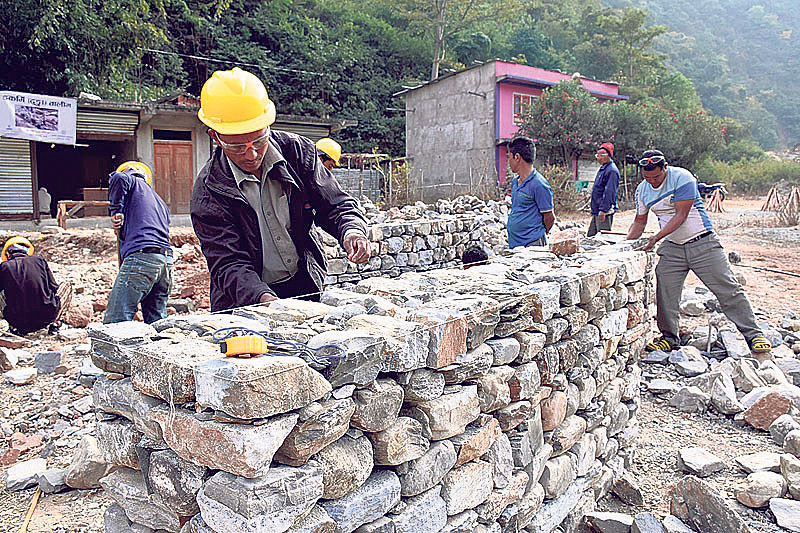Government needs to ensure that reconstruction carried on individual basis or through I/NGOs meets safety standards
Safe and affordable housing has long been a distant dream for many Nepalis in rural areas. People in the past followed orthodox and non-scientific construction practices.
Consequently, those structures were flattened by the devastating earthquakes of April/May, 2015, in which thousands lost their lives and hundreds of thousands were displaced.
Nearly two years later, earthquake victims still don’t know how to build safer houses, and continue to languish in makeshift shelters. The government’s reconstruction efforts are taking place at snail’s pace. Effectiveness and efficiency of slightly more active I/NGOs remain questionable. The victims are braving cold and rain and waiting for help. The government neglect of the plight of quake victims has affected them psychologically, economically and socially.
NEPSE added 29.31 points, while investors gained Rs 47 billion...

 House construction training being provided in Mangaltar of Kavre district. (Republica)
House construction training being provided in Mangaltar of Kavre district. (Republica)
The victims saw their houses made of stone and mortar collapse and kill their relatives in front of their eyes. This has left disturbing imprints on their mind. They have not been able to come to terms with the psychological trauma yet. But they have no option to rebuilding out of the remains of the collapsed structures.
During our visit to rural parts of Nuwakot, Rashuwa and Sindhupalchowk, we found that the cost of rebuilding is the most worrying factor. A simple stone-and-cement mortar house costs about Rs 600,000. The government grants are way short of this amount required to build a home of minimum safety standards.
Mass exodus of young people from our villages to Gulf countries has resulted in big human resource crunch at local level. Only a few youth, elderly and women are left in the villages and the cost of labor is very high. This has further contributed to tardy reconstruction. Besides, the available masons are unaware of safe construction practices.
The other hurdle facing the rural poor in rebuilding is poor or complete lack of transportation access. Many roads linking rural villages are seasonal, where transportation is possible only in dry season. Large boulders and red mud contribute to landslides during the rainy season, disrupting smooth transport of cement, building rods and aggregates (which are not available in most villages). This increases price of building material and duration of construction.
Even more dangerous is the expectation that some organizations will come and build the houses for them. Let me illustrate this with a story.
We were at Satdobato, Nuwakot to oversee rural reconstruction and to explore possible intervention from our side. We came across a junction where construction work was going on. Some (mostly elderly) were working wearing construction aprons. Nearby, a group of young people were playing cards and gossiping. I was taken aback. This was not the rural Nepal I knew.
Out of curiosity I approached them and asked why they did not help the elderly. They said that this particular bit of construction was funded by a certain INGO. They said they would work only when some other INGO comes to fund rebuilding of their houses.
This is the trend in all earthquake-affected districts. People tend to believe there will always be someone to do the work for them. This increased dependency on I/NGO has pushed reconstruction work further back.
Although there has been little progress in building safe and affordable houses, it would be wrong to say no work has been done. “As many as 27 proposals have been tabled,” says Ravi Shah, Deputy Director General at Department of Buildings, “all of which promise to be locally feasible and safe.”
There are companies and organizations (though few) working to provide safe and affordable rural housing, using locally available materials and human resources. They have been fairly successful so far, having constructed model houses across almost all earthquake-affected districts and having transferred the skills of safe construction to others. But this is not enough.
Government needs to ensure these companies and organizations provide services only after meeting certain structural requirements. This will ensure safe and sustainable rebuilding. Only then will the victims will get safe houses to live in.
The government also needs to ensure that reconstruction carried out on individual basis or through I/NGOs meets safety standards. Due to lack of construction materials people were seen excavating stone, sands, mud and aggregate for rebuilding purpose. This will make our terrains more vulnerable so haphazard extraction of construction materials should be discouraged.
Besides, it is as important to build motor roads in affected districts so that reconstruction gathers pace before the chill really begins to bite. The government should also look to maintain uniformity in construction material cost through regular inspections.
I/NGOs for their part need to ensure that the money they are providing is being utilized in construction and nothing else. Great care should be taken not to make the rural folks dependent on external help.
Home is the basic foundation, the nucleus of everything in Nepali society. A good home will certainly boost the confidence of long-suffering quake victims.
Every destruction brings with it the possibility of better reconstruction. We now have an opportunity to change the face of our rural heartlands, to build back better and to institute the change we dream of.
The author, the chief financial officer at Creative Services Private Limited, is involved in rural reconstruction

































